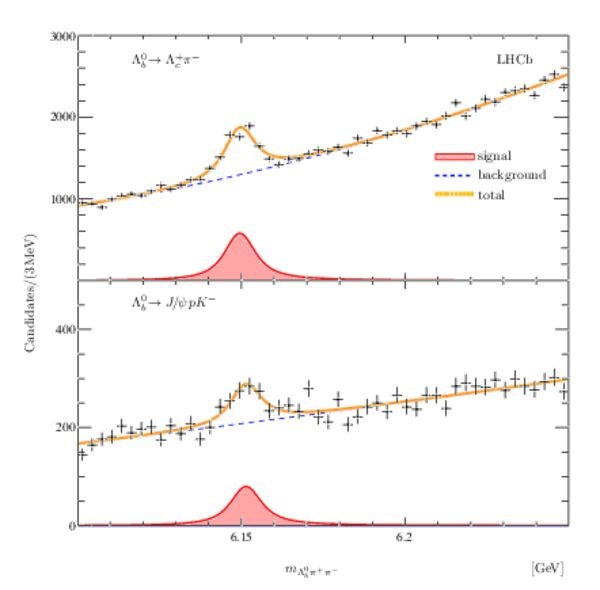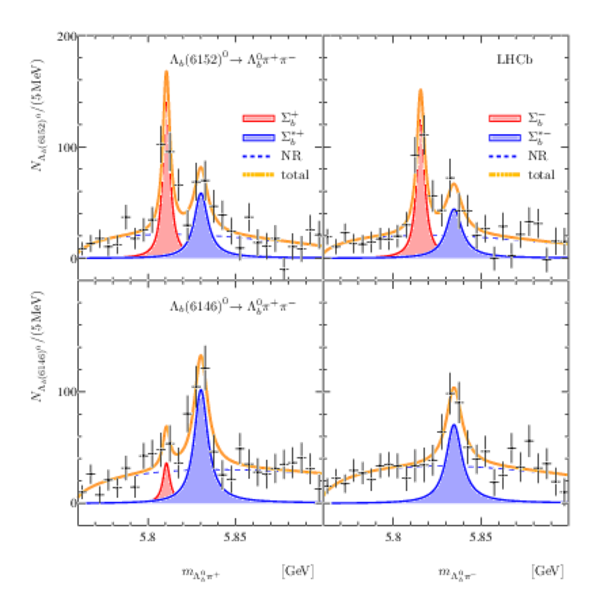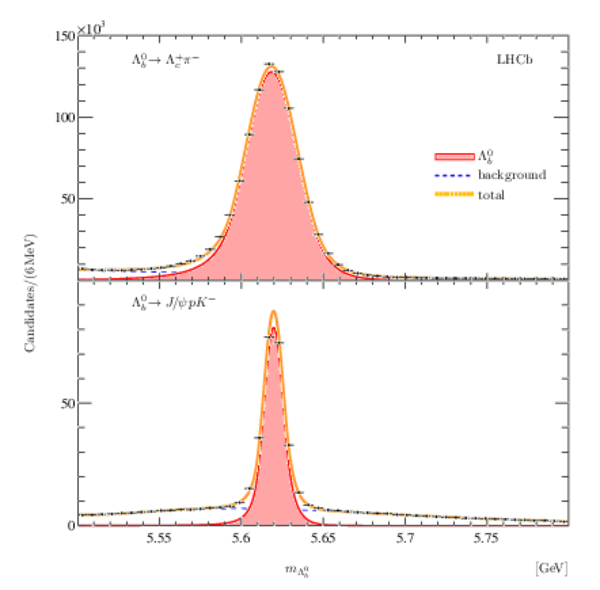Information
LHCb-PAPER-2019-025
CERN-EP-2019-153
arXiv:1907.13598 [PDF]
(Submitted on 31 Jul 2019)
Phys. Rev. Lett. 123 (2019) 152001
Inspire 1747307
Tools
Abstract
We report the observation of a new structure in the $\Lambda_b^0 \pi^+\pi^-$ spectrum using the full LHCb data set of $pp$ collisions, corresponding to an integrated luminosity of $9 \mathrm{fb}^{-1}$, collected at $\sqrt{s}=7$, 8 and $13 \mathrm{TeV}$. A study of the structure suggests its interpretation as a superposition of two almost degenerate narrow states. The masses and widths of these states are measured to be \begin{eqnarray*} m_{\Lambda_{b}\mathrm{(6146)}^0} &=&6146.17 \pm 0.33 \pm 0.22 \pm 0.16 \mathrm{MeV} , m_{\Lambda_{b}\mathrm{(6152)}^0} &=&6152.51 \pm 0.26 \pm 0.22 \pm 0.16 \mathrm{MeV} , \Gamma_{\Lambda_{b}\mathrm{(6146)}^0}&=&\phantom{615}2.9\phantom{0}\pm 1.3\phantom{0} \pm 0.3\phantom{0} \mathrm{MeV} , \Gamma_{\Lambda_{b}\mathrm{(6152)}^0} &=&\phantom{615}2.1\phantom{0}\pm 0.8\phantom{0} \pm 0.3\phantom{0} \mathrm{MeV} , \end{eqnarray*} with a mass splitting of $\Delta m = 6.34 \pm 0.32 \pm 0.02 \mathrm{MeV}$, where the first uncertainty is statistical, the second systematic and the third derives from the knowledge of the mass of the $\Lambda_b^0$ baryon. The measured masses and widths of these new excited states suggest their possible interpretation as a doublet of $\Lambda_{b}\mathrm{(1D)}^0$ states.
Figures and captions
|
Mass distribution of selected $\Lambda ^0_ b \pi ^+ \pi ^- $ candidates for the (top) $\Lambda ^0_ b \rightarrow \Lambda ^+_ c \pi ^- $ and (bottom) $\Lambda ^0_ b \rightarrow { J \mskip -3mu/\mskip -2mu\psi \mskip 2mu} p K ^- $ decay modes. |
Fig_1.pdf [115 KiB] HiDef png [290 KiB] Thumbnail [217 KiB] tex code |

|
|
Mass distributions of selected $\Lambda ^0_ b \pi ^+ \pi ^- $ candidates for the three regions in $\Lambda ^0_ b \pi ^{\pm}$ mass: (top) $\Sigma_{ b }$, (middle) $\Sigma_{ b }^{\ast}$ and (bottom) nonresonant (NR) region. |
Fig_2.pdf [124 KiB] HiDef png [400 KiB] Thumbnail [300 KiB] tex code |

|
|
Background-subtracted mass distribution of (left) $\Lambda ^0_ b \pi ^+ $ and (right) $\Lambda ^0_ b \pi ^- $ combinations from (top) $\Lambda_{ b }\mathrm{(6152)}^0 \rightarrow \Lambda ^0_ b \pi ^+ \pi ^- $ and (bottom) $\Lambda_{ b }\mathrm{(6146)}^0 \rightarrow \Lambda ^0_ b \pi ^+ \pi ^- $ decays. Results of fits with a model comprising $\Sigma_{ b }$, $\Sigma_{ b }^{\ast}$ and nonresonant (NR) components are superimposed. |
Fig_3.pdf [137 KiB] HiDef png [481 KiB] Thumbnail [347 KiB] tex code |

|
|
Mass distribution of selected $\Lambda ^0_ b $ candidates from the (top) $\Lambda ^0_ b \rightarrow \Lambda ^+_ c \pi ^- $ and (bottom) $\Lambda ^0_ b \rightarrow { J \mskip -3mu/\mskip -2mu\psi \mskip 2mu} p K ^- $ decay modes. |
Fig_4.pdf [108 KiB] HiDef png [312 KiB] Thumbnail [201 KiB] tex code |

|
|
Animated gif made out of all figures. |
PAPER-2019-025.gif Thumbnail |

|
Tables and captions
|
The yields, $N$, masses, $m$, and natural widths, $\Gamma$, from the fits of a single broad state to the $\Lambda ^0_ b \pi ^+ \pi ^- $ mass spectra. |
Table_1.pdf [89 KiB] HiDef png [37 KiB] Thumbnail [18 KiB] tex code |

|
|
Summary of the systematic uncertainties for the masses, $m$, and widths, $\Gamma$, of the $\Lambda_{ b }\mathrm{(6146)}^0$ and $\Lambda_{ b }\mathrm{(6152)}^0$ states. All values are in $\mathrm{ ke V}$ . |
Table_2.pdf [55 KiB] HiDef png [50 KiB] Thumbnail [20 KiB] tex code |

|
|
The signal yields for $\Lambda ^0_ b \rightarrow \Lambda ^+_ c \pi ^- $ and $\Lambda ^0_ b \rightarrow { J \mskip -3mu/\mskip -2mu\psi \mskip 2mu} p K ^- $ decays. |
Table_3.pdf [74 KiB] HiDef png [50 KiB] Thumbnail [21 KiB] tex code |

|
|
The yields of the $\Lambda_{ b }\mathrm{(6146)}^0$ and $\Lambda_{ b }\mathrm{(6152)}^0$ signals in the three $\Lambda ^0_ b \pi ^{\pm}$ mass regions. |
Table_4.pdf [80 KiB] HiDef png [43 KiB] Thumbnail [20 KiB] tex code |

|
|
The yields, $N$, and statistical significance, ${\mathcal{S}}_{\mathrm{W}}$, of the $\Lambda_{ b }\mathrm{(6146)^0} \rightarrow \Sigma_{ b }^{(\ast)\pm}\pi ^{\mp} $ and $\Lambda_{ b }\mathrm{(6152)}^0 \rightarrow \Sigma_{ b }^{(\ast)\pm}\pi ^{\mp} $ signals from the fits to the background-subtracted $\Lambda ^0_ b \pi ^{\pm}$ mass distributions. |
Table_5.pdf [64 KiB] HiDef png [133 KiB] Thumbnail [63 KiB] tex code |

|
Created on 19 April 2024.
